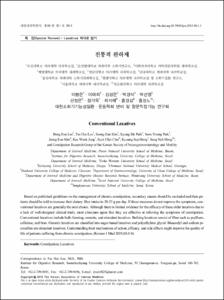KUMEL Repository
1. Journal Papers (연구논문)
1. School of Medicine (의과대학)
Dept. of Internal Medicine (내과학)
전통적 완하제
- Keimyung Author(s)
- Park, Kyung Sik
- Department
- Dept. of Internal Medicine (내과학)
- Journal Title
- 대한내과학회지
- Issued Date
- 2015
- Volume
- 88
- Issue
- 1
- Abstract
- Based on published guidelines on the management of chronic constipation, secondary causes should be excluded and then patients
should be told to increase their dietary fiber intake to 20-25 g per day. If these measures do not improve the symptoms, conventional
laxatives are generally the next choice. Although there is limited evidence for the efficacy of these older laxatives due to
a lack of well-designed clinical trials, most clinicians agree that they are effective at relieving the symptoms of constipation.
Conventional laxatives include bulk-forming, osmotic, and stimulant laxatives. Bulking laxatives consist of fiber such as psyllium,
cellulose, and bran. Osmotic laxatives are classified into sugar-based laxatives and polyethylene glycol. Bisacodyl and sodium picosulfate
are stimulant laxatives. Understanding their mechanisms of action, efficacy, and side effects might improve the quality of
life of patients suffering from chronic constipation. (Korean J Med 2015;88:1-8)
Keywords: Constipation; Laxatives
- Alternative Title
- Conventional Laxatives
- Keimyung Author(s)(Kor)
- 박경식
- Publisher
- School of Medicine
- Citation
- 이봉은 et al. (2015). 전통적 완하제. 대한내과학회지, 88(1), 1–8. doi: 10.3904/kjm.2015.88.1.1
- Type
- Article
- ISSN
- 1738-9364
- Appears in Collections:
- 1. School of Medicine (의과대학) > Dept. of Internal Medicine (내과학)
- 파일 목록
-
-
Download
 oak-bbb-00635.pdf
기타 데이터 / 295.1 kB / Adobe PDF
oak-bbb-00635.pdf
기타 데이터 / 295.1 kB / Adobe PDF
-
Items in Repository are protected by copyright, with all rights reserved, unless otherwise indicated.